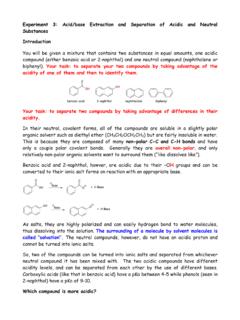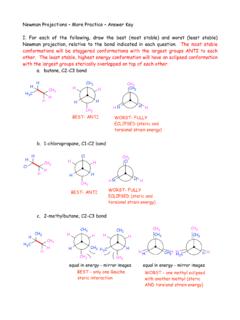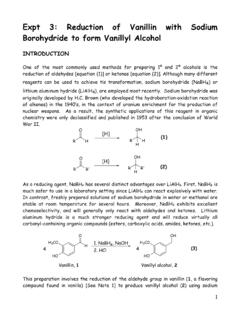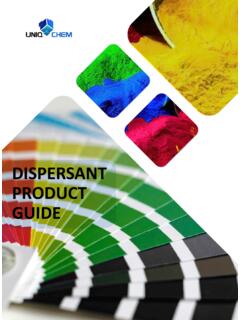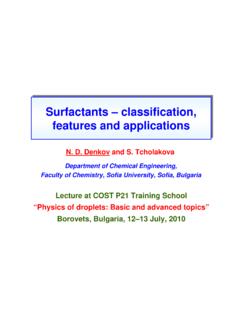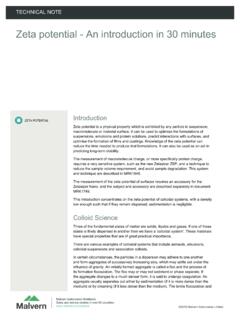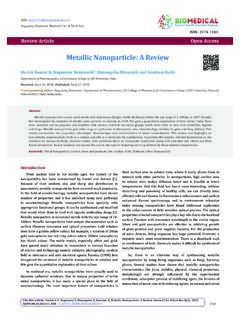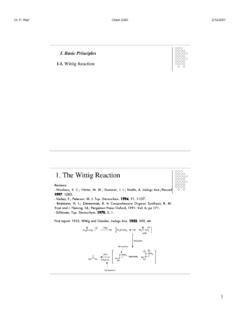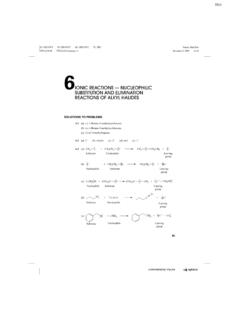Transcription of Reactions of Alkyl Halides - Towson University
1 Reactions of Alkyl Halides This is probably the most confusing chapter in the first semester of organic chemistry, the Reactions of Alkyl Halides . Alkyl Halides undergo two basic types of Reactions in organic chemistry, including substitutions and eliminations. There are two types of substitution Reactions and two types of elimination Reactions . We will look at each individually and then try to compare and contrast so you know what identifying characteristics to look for, to help you recognize which reaction is most likely to occur. Remember though, that there are exceptions to most rules. As defined and black and white as we might wish life to be, sometimes we have to deal in grey. Substitutions: Ex. AB + CD AC + BD There are two types of Substitutions Reactions . 1. The SN2 reaction Substitution : one species replaces another (self-explanatory) Nucleophilic : the substitution occurs as the result of attack by an electron-rich species Bimolecular : two species are involved in the rate-determining step (the slowest of the mechanism) Bimolecular: Dealing with the rate of the reaction.
2 The rate of any SN2 reaction is directly linked to the concentration of two species, the Nucleophile (Nuc) and the Alkyl halide (RX) undergoing substitution. Both of these species are involved in the rate-determining (thus slowest) step. The rate equation would be: Rate = k[Nuc][RX], where k is a constant based on what species are actually involved. It is important to remember that, as a result, if you double the concentration of either, you double the reaction s rate. If you cut the concentration in half for either, the rate will also be cut in half. The rate of the reaction is directly linked to the number of times these two species can collide to react together. Change the concentration and you change the number of possible collisions! An example of an SN2 reaction: BrH3CH2CH3CH+ OHHOCH2CH3CH3H+ Br Mechanism of SN2: There are actually two potential ways the nucleophile could attack: Frontside attack: BrH3CH2CH3CH+ OH The attack from the frontside (the side the leaving group is on) is disfavored for two reasons.
3 First, there s sterics the nucleophile is trying to attack in the same space the leaving group is trying to leave. Second, there s electronics the nucleophile is trying to attack bearing a full negative charge and the leaving group is trying to leave with a full negative charge, and they will repel each other ( electrostatic repulsions) Backside attack: BrH3CH2CH3CH OH Attack from the backside, where the nucleophile comes in from the opposite side of the leaving group, alleviates both the electronic and steric issues seen in the frontside attack. This is a one-step concerted ( happens all at once) process where all the bond formations and breakages occur simultaneously. There aren t any intermediates formed (no anions, cations, etc) and it is surmised based on the results that the following is an accurate depiction of the transition state of the process: BrH3CH2CH3CH+ OHHOCH2CH3CH3H+ BrH3 CHBrHO!"!"CH2CH3 Any chiral center that was once perhaps the S configuration, as shown in the starting material here, winds up inverting its stereochemistry and becoming the R configuration.
4 Centers that are not chiral cannot show this inversion but the inversion process is still occurring. Transition State of SN2: The original starting material was sp3 hybridized but note that the transition state resembles sp2 hybridization (turned on its side with the nucleophile, OH, and the group that s leaving, Br, where the perpendicular p orbital might once sit). It is this planar geometry and the need to put the other groups through the inversion into this planar state that define what Alkyl Halides can undergo the SN2 reaction. Transition State: H3 CHBrHO!"!"CH2CH3 You can see how both the Nuc and the Br are involved in this rate-determining step. Bimolecular! Factors that affect the SN2: 1. Alkyl Halide: steric congestion around the carbon atom undergoing the inversion process will slow down the SN2 reaction. Less congestion = faster reaction! CH3-X > RCH2-X > R2CH-X >>>>>>>>>>>> R3C-X Methyl Halides and 1 Halides are the best at undergoing SN2 Reactions , 2 Halides are OK but 3 Halides cannot go through the inversion process and will never do this reaction.
5 The transition state is too crowded. 2. Leaving Group: The leaving group is almost always expelled with a full negative charge. As a result, the best leaving groups are those that can best stabilize an anion ( a weak base). Best: OMs, OTos > I , Br > Cl > F ( OH, NH2) (Worst) OMs = Mesylate group (methanesulfonate group) [shown below, left] OTos = Tosylate group (para-toluenesulfonate group) [shown below, right] Both are extremely good leaving groups due to resonance stabilization : CH3 SOOOCH3 SOOO 3. Solvent: The rate of the reaction can be affected by the energy level of the reagents. Solvation is the surrounding of a species in a reaction by the solvent molecules themselves, creating a cage of solvent molecules. This can cause a reaction to go faster or slower, depending on what the solvent is surrounding. There are two types of solvents, generally speaking: a. Protic Solvents: Solvation occurs with the nucleophile, where the protic solvent hydrogen bonds to the anion that is trying to attack the Alkyl halide.
6 This creates a shield around the nucleophile and slows down the reaction dramatically. Examples would include water or alcohols (ROH). Notice in the diagram below how the water molecules have oriented themselves so that the partially positively charged protons are all surrounding the anionic Nucleophile. It s not getting anywhere very fast now! NucHOHHOHHOHHOHHOHHOH b. Aprotic (Polar) Solvents: Every nucleophile with a full negative charge is in the reaction with some sort of metal counterion (typically Na, Li or K). Aprotic, polar solvents cause solvation of the counterion occurs, exposing the nucleophile, with its anionic charge, to need to react even more. The nucleophile is destabilized and faster to react. Examples of aprotic polar solvents might be DMSO [dimethylsulfoxide (CH3S(O)CH3)], DMF [(dimethylformamide, (CH3)2 NCHO)] or acetonitrile, CH3CN. Notice how the acetonitrile, with its partial positively negative nitrogen atom is totally surrounding the sodium counterion.
7 That Nucleophile NEEDS to find something to react with! N CCH3 NaNucNCCNCCH3 NCH3 CNCH3 CNCH3 CNCCH3 NCCH3 4. Nucleophiles: a. Strong bases are strong nucleophiles, and vice versa. Full negative charges are always more basic and also more nucleophilic. (Hint: Look for Na, K, Li : they always are positively charged counterions that are associated with full negative charges) Ex. OCH3 versus HOCH3better base! better Nuc! b. The strength of a nucleophile is reduced by the presence of electron-withdrawing groups (EWG). Electron density is removed from the attacking atom, reducing its strength. Ex. The chlorine atoms pull e- density away from the attacking carbon weaker nucleophile. CH3 versus CCl3 b etter N uc!CClClCl c. The strength of a nucleophile increases for atoms down the column of the periodic table Ex: SH versus OH better Nuc! d. Resonance stabilization results in spreading out the anion of the nucleophile, making it less concentrated, thus weaker.
8 Notice that in the two resonance forms below, the anion is located on both oxygens, effectively splitting the negative charge between the two atoms. Its not concentrated on a single atom, thus it s a weaker nucleophile. Ex: OCH2CH3 versus better Nuc!OCOCH3 OCOCH3 2. The SN1 reaction Substitution : one species replaces another (self-explanatory) Nucleophilic : the substitution occurs as the result of attack by an electron-rich species Unimolecular : one species are involved in the rate-determining step (the slowest of the mechanism) Unimolecular: Dealing with the rate of the reaction. The rate of any SN2 reaction is directly linked to the concentration only one species, the Alkyl halide (RX) undergoing substitution. This is the only species involved in the rate-determining (thus slowest) step. The rate equation would be: Rate = k[RX], where k is a constant based on what species is actually involved. It is important to remember that, as a result, if you double the concentration of the nucleophile, there will be NO EFFECT on the rate of the reaction.
9 Go ahead add as much as you want it won t make the reaction any faster! But cut the concentration of the Alkyl halide in half and the reaction will slow down by half only half as many Alkyl Halides are undergoing reaction! An example of an SN1 reaction: CXCrate-determiningstep ( slow!)+ NucCNuc+ X The rate of reaction is dependent on the formation of a carbocation intermediate from the Alkyl halide. It is the rate of the spontaneous dissociation of the leaving group that determines how fast this reaction goes. Specific example: BrH3CH2CH3C+ H2 OHOCH2CH3CH3 OHH3CH2CH3C+ Notice how one of the products looks almost exactly like the starting material but the other is its mirror image. When chiral compounds undergo SN1 reaction, they form a racemic mixture of enantiomers! Mechanism of SN1: OCH2CH3CH3 HOHOH3CH2CH3C+BrH3CH2CH3 CCH2CH3H3 CHHHHHOCH2CH3CH3 OHH3CH2CH3C+ Br+ HBr In the first step, a carbocation forms.
10 This results in an empty p orbital that can be attacked by the nucleophile from either the right side or the left side. As a result, a mixture of two possible chiral centers occurs. In the last step, the bromide anion scavenges the extra proton from the oxygen, to produce the final products. Both retention and inversion of configuration = formation of racemic mixture from chiral material (loss of optical activity) Factors that affect the SN1: 1. Alkyl Halide: the more stable the carbocation, the faster it can form. (Recall: both hyperconjugation and the inductive effect allow Alkyl groups to stabilize carbocations). The more stable carbocation intermediate has a lower activation barrier, so the SN1 reaction occurs faster. Order of reactivity: At a first glance: 3 carbocations > 2 carbocations >>>>>>>>> 1 carbocations or methyl carbocations Add in resonance stabilization and these carbocations become even more stable!






